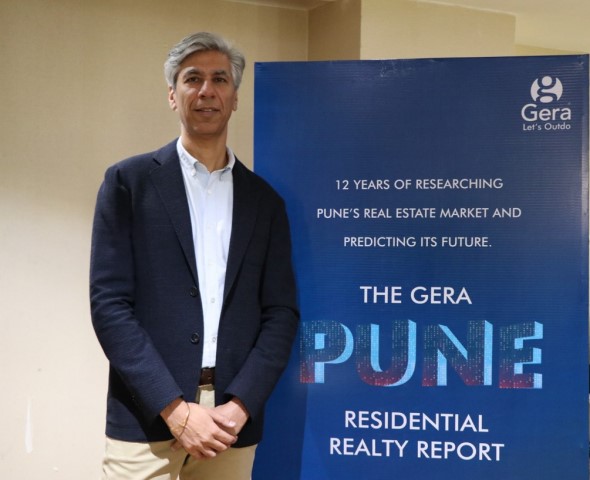An overall increase of 10.85% in home prices and new launches rise by 17% in 2022
- The average prices of homes across Pune city have increased by 10.85% in the last 12 months. From an average of Rs. 4,926 per sq. ft. in December 2021 to an all-time high of Rs 5,461 per sf in December 2022.
- There is a rise in prices across the board especially in the new projects where prices have gone up by more than 23% in the last 12 months.
- There has been a clearing of ready and almost ready inventory – currently at 6% of all available units as on Dec 22 which is at a 10-year low.
- For the first time, affordability goes down to 3.71 after more than 8 years of affordability improving every year. Despite increases in interest rates, affordability continues to be strong.
- Inventory available for sale has increased marginally by 0.5%.
- Overall inventory for sale at 72,129 units, is healthy at 23.21% of the total inventory under development (76.79% is sold out).
PUNE: Gera Developments, the pioneers of real estate business and the award-winning creators of premium residential and commercial projects in Pune, Goa, and Bengaluru, today released the January 2023 edition of their bi-annual report, titled ‘The Gera Pune Residential Realty Report’. It is based on primary and proprietary research conducted by Gera Developments and covers all existing projects in a 30 km radius of the city center. The report is an outcome of the longest-running, census-based study of the residential realty market of Pune.
According to the latest Gera Pune Residential Realty Report for the period June 2022 to December 2022, on the surface, all parameters look very strong. Home prices at an average rate of Rs. 5,461 per sq. ft. are not even 8% above the previous peak of Rs. 5,096 in December 2015. The salary increases over this period have more than compensated for the increase in interest rates. Home prices have seen an increase of 10.85% in 2022. The average rates have increased from Rs. 4,926 per sq. ft. in Dec ’21 to Rs. 5,461 per sq. ft. in Dec ’22. Fresh supply launched in the last six months remains at an elevated level however, compared to the six-monthly period ended Dec ’21, fresh supply has decreased by 22%, and compared to the six-monthly period ended Jun ’22, it has decreased by 13% indicating that new launches are happening at a healthy level but not at the furious pace seen in the past.
Overall inventory for sale is healthy at 72,129 homes i.e., 23.21% of the total inventory under development which is at 310,725 homes. This gross inventory number has been reasonably stable since Dec ’15. The replacement ratio is also stable at 0.95. Inventory overhang is at an all-time low of 8.37.
Talking about the findings of The Gera Residential Realty Report January 2023 edition and the latest trends in Pune’s residential real estate market, Mr. Rohit Gera, Managing Director, Gera Developments, said, “The Pune real estate market has had a good 2022 – this is in line with other real estate markets across the country. Rising interest rates have not had much of an impact on the overall market adversely; while some sales may have been affected, the salary increase over this period has more than compensated for the increase in interest rates. The future, however, has greater uncertainty due to macroeconomic and global factors. We see increased global headwinds and layoffs affecting employment in the IT sector. We believe a larger issue in addition to affordability (which at the present time is not a cause for concern), is job security.”
“Regardless of affordability, job insecurity may cause people to put off their decision to make a large purchase like a home. While thus far India seems relatively less affected, and we are being touted as a beacon of hope for the rest of the world, layoffs in the tech sector and a corresponding erosion of sentiment would have an impact on the sales of homes.”
“The introduction of the unified development control rules has led to a substantial increase in the development potential across the Pune Municipal Corporation and Pimpri Chinchwad Municipal Corporation jurisdictions. One of the outcomes of this is the increased sizes of projects.”
He further added, “The big impact of this increased development potential will be seen once the unified DC rules are made applicable in the PMRDA region. The PMRDA has the largest area under its jurisdiction. These areas have lesser development, and the rates are generally lower. Higher densities lead to the greater cost of construction as densification effectively leads to taller buildings, additional parking created in podiums, etc.”
He also underlined the increase in the cost of construction for developers and said, “The increased densification will therefore lead to an increased cost of construction as well as potentially increased supply. Thus far, supply is running in tandem with demand and hence the market continues to be buoyant. On the surface of it, things look very good. Time will tell which, whether job security and oversupply, take the market down.”
Here are the key highlights of The Gera Pune Residential Reality report, encompassing trends from July 2022 to December 2022:
# New launches rise by 17% on an annual level
The supply squeeze prevalent in the Pune residential real estate space during both COVID phases has led to developers launching new units to meet the demand for residential real estate. Fresh supply launched in the last 6 months remains at an elevated level however, compared to the six-monthly period ended Dec ’21, fresh supply has decreased by 22% and compared to the six-monthly period Jun ’22, it has decreased by 13% indicating that new launches are happening at a healthy level.
At an annual level, new launches have grown by ~17% i.e 102,332 homes were launched in the last 12 months compared to the growth rate of 49% from 2020 to 2021 again underlining the fact that growth rates are normalizing as the market reverts to sustainable levels.
However, if the last 12 months are any indication, the new launch pipeline remains strong and operational metrics like the replacement ratio and inventory overhang don’t point to any red flags in the near term.
# Inventory available for sale increases marginally by 0.5%
The current inventory available for sale at 72,129 homes is classified into 4 stages based on construction status. i.e., Early, Mid, End, and Ready. Early-stage inventory constitutes ~31% of all available units for sale as on Dec ’22. The early-stage inventory, at ~30% a year ago, has roughly remained at the same levels.
The reduction in the number of apartments Is the most in the early-stage projects which at peak add 45,000 homes available for sale has come down to approximately 23,000 homes currently.
# Luxury seeing a +71% growth and PremiumPlus seeing a +21% growth in new homes being added
Looking at the last 12 months of new launches by price segments, the trend of Luxury (Prices Rs 8,261+ per sq. ft.) and PremiumPlus (Prices between Rs 6,610 per sq. ft. and Rs 8,261 per sq. ft.) seeing growth continues with Luxury seeing a +71% growth and PremiumPlus seeing a +21% growth compared to last year. The Budget (<Rs 4,406 per sq. ft.) segment has also picked up steam clocking a 31% growth albeit on a lower base. While on an overall basis and compared to last year, new launches across the market have shown a growth of 17%, the Value (Rs 4,407 per sq. ft. to 5,507 per sq. ft.) & Premium (Rs 5,508 per sq. ft. to 6,609 per sq. ft.) segments have been laggards showing a muted growth of 2% and 9% respectively.
# Sales have increased by 11% on a yearly level
Comparing sales velocity in H2 2021 to H2 2022, there is a 4% decrease in offtake (from 52,227 units to 50,036 units). Sequentially (compared to H1 2022) the offtake has dropped by 7%. However, Volume remains comfortable above 50,000 units for the last 3 six monthly periods indicating no red flags. As was the case with new launches – the single-digit degrowth is attributable to the markets becoming more normalized and sustainable.
The Budget and Value segment continues to lose favor with customers – both these segments have decreased by -11% and -19% – while Premium, PremiumPlus and Luxury segments continue to find favor displaying positive growth. In the PremiumPlus segment growth is marginal while the Premium and Luxury segments have high double-digit growth of 15% & 29%. Clearly, the Budget and Value segment is the one pulling down the sales growth rate while the other segments remain unaffected.
# Market continues its trend toward larger projects
The number of large projects (those with more than 500 units) as on Dec ’22 is 167. This number has increased from 123 projects in Dec ’18 to 167 now. In Dec ’18, these 123 projects constituted 3.5% out of the total of 3,525 projects being developed. In Jun ’22, 167 projects constituted 7% out of the total of 2,509 projects being developed.
# Affordability reduces for the first time to 3.71x annual income after more than 8 years
Homes have become less affordable however, on an overall basis, affordability continues to be very strong at 3.71x annual income. Over time interest rates have decreased, while incomes have risen thereby increasing affordability significantly. However, this cycle may have bottomed out with home prices as well as interest rates rising significantly. Input costs for developers have forced developers to raise prices. Increasing interest rates and inflation get the home buyer less per rupee, and hence the affordability equation though still healthy can still create headwinds for developers.
As per the report, in Jun ’11, the salary needed to buy a 1,000 sq. ft. home was 4.83 times the cost of the home. This peaked in Dec ’14 when the salary needed to buy the same 1,000 sq. ft. house at the increased salary and increased rates were 5.27 times. Since Dec ’14, the consistent reduction in interest rates and home prices along with the salary increments have led to a situation where the house cost for a 1,000 sq. ft home is now at 3.71 times the salary. However, affordability has decreased compared to Dec ’21 from 3.56 to 3.71 primarily due to the combined increase in interest rates from 7.7% in Dec ’21 to 9.6% in Dec ’22 and prices from Rs 4,926 per sq. ft. to Rs 5,461 per sq. ft.
After witnessing furious growth in the past in terms of sales and new launches – markets have streamlined at sustainable levels. Prices have increased by 10.85% across all projects over the last 12 months. While yearly growth in offtake and new launches remains at healthy levels – on a six-monthly basis both offtake and new launches have decreased by -4% and -22%. Larger sizes continue to do well in terms of offtake and find favor with customers. The replacement ratio is 0.95 indicating that demand is greater than supply while inventory overhang is <9 months, reiterating that market fundamentals remain strong in the near to medium term.


